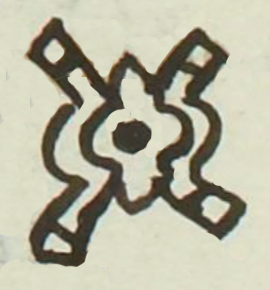Olin (MH574r)
This black-line drawing of the compound glyph for the personal name Olin (“Movement,” attested here as a man’s name) shows a frontal view of a quincunx (a quadripartite symbol with a center), which is known to represent movement (olin) such as that relating to earthquakes but also the jiggling and bouncing of rubber balls, among other forms of movement. At the center is what may be a black rubber ball (olli), serving as both a phonetic and semantic indicator or complement. The "wings" of the movement sign (if that is what they are) here bracket a central axis that has a point at the top. The wings also have small squares at the four tips. These squares are a feather that stands out as somewhat different from other examples (see below).
Stephanie Wood
Olin was a day name in the 260-day divinatory calendar called the tonalpohualli in Nahuatl. This calendar had a role in various Mesoamerican religions, including the Mixtec.
Stephanie Wood
dieo. ollin
Diego Olin
Stephanie Wood
1560
Jeff Haskett-Wood
movement, movimiento, temblores, terremotos, hule, pelotas, quincunces

ol(in), movement, https://nahuatl.wired-humanities.org/content/olin
Matrícula de Huexotzinco, folio 575r, https://www.loc.gov/resource/gdcwdl.wdl_15282/?sp=229&st=image
This manuscript is hosted by the Library of Congress and the World Digital Library; used here with the Creative Commons, “Attribution-NonCommercial-ShareAlike 3.0 License” (CC-BY-NC-SAq 3.0).










